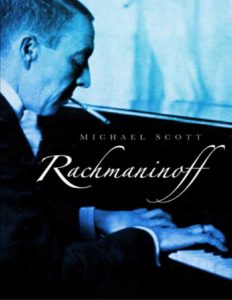Browse in the Library:
Rachmaninoff Musical Momment Op. 16 No 4 in E minor with sheet music

Rachmaninoff sheet music download.
Browse in the Library:
The fourth piece in Russian composer Sergei Rachmaninoff’s “Moments Musicaux, Op. 16” is similar to the second in the quality of its performance. The fourth piece reveals resemblance to Chopin’s “Étude Op. 10 No. 12” in the taxing left-hand figure place throughout. Further, it looks, sounds, and feels as if it were an improvisation on Chopin’s Prelude in G major (Op. 28, No. 3).
The piece is 67 measures long, with a duration of about three minutes, and has the fastest tempo of the set, Presto (quick) at 104 quarter notes per minute, and is the shortest work in terms of playing time. Presto is in ternary form with a coda. The piece begins with a fortissimo introduction with a thick texture in the left hand consisting of chromatic sextuplets.
The melody is a “rising quasi-military” idea, interspersed between replications of the left-hand figure, the mostly two-note melody being a strong unifying element. The middle section is a brief period of pianissimo falling figures in the right hand and rising scales in the left. The third section is marked Più vivo (more life) and is played even faster than the intro, 112 quarter notes per minute. At this point the piece develops a very thick texture, with the original left hand figure played in both hands in varying registers.
The technique of rapidly changing the octave in which a melody is played, sometimes called “registral displacement”, is used to present the figure in a more dramatic form that increases the intensity of the ending. The ending, a coda in Prestissimo (very quick), 116 quarter notes per minute, is a final, sweeping reiteration of the theme that closes in a heavy E minor chord, which revisits Rachmaninoff’s preoccupation with bell sounds, prominent in his Piano Concerto No. 2 and Prelude in C-sharp minor (Op. 3, No. 2).
The piece is a major exercise in endurance and accuracy: the introduction opens in a left hand figure requiring span of a tenth interval. Additionally, octave intervals invariably appear before fast sextuplet runs, making quick wrists and arm action necessary. The double melodies Rachmaninoff uses in this work exists purposely to “keep both hands occupied,” obscuring the melody and making it difficult for the right hand to project. This is the only piece in the set with indicated pedal markings. (From Wikipedia)
